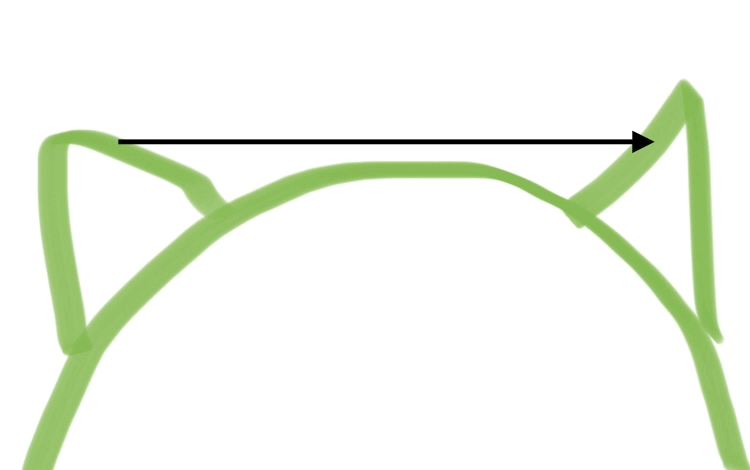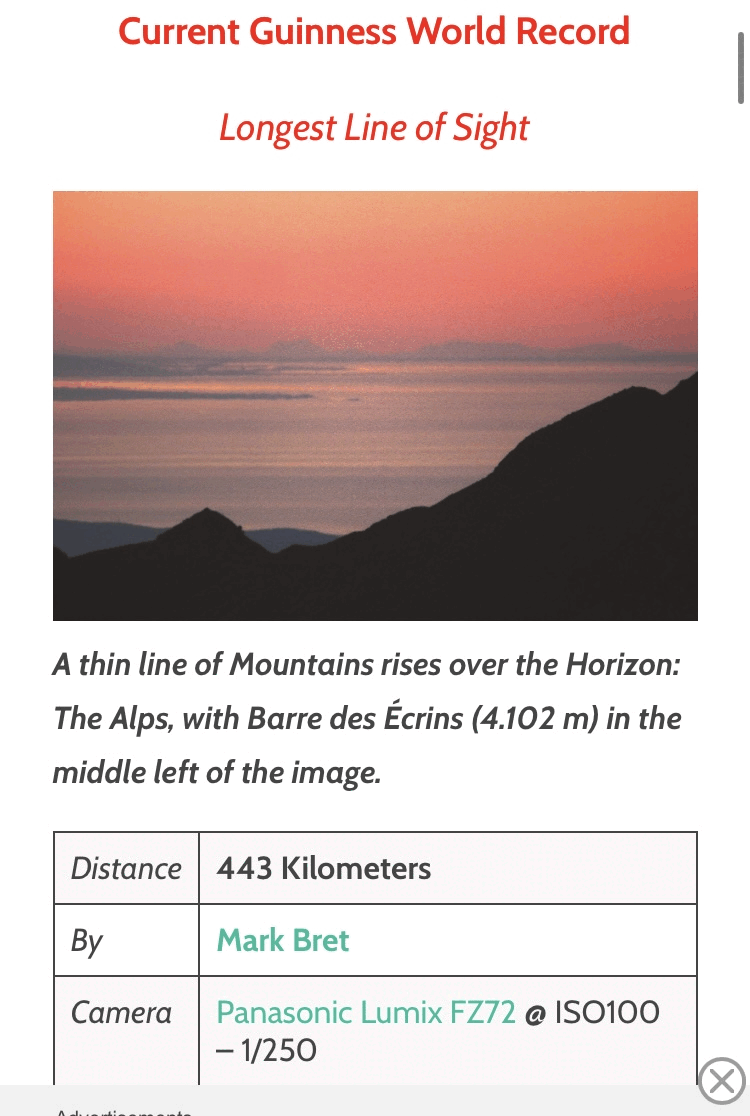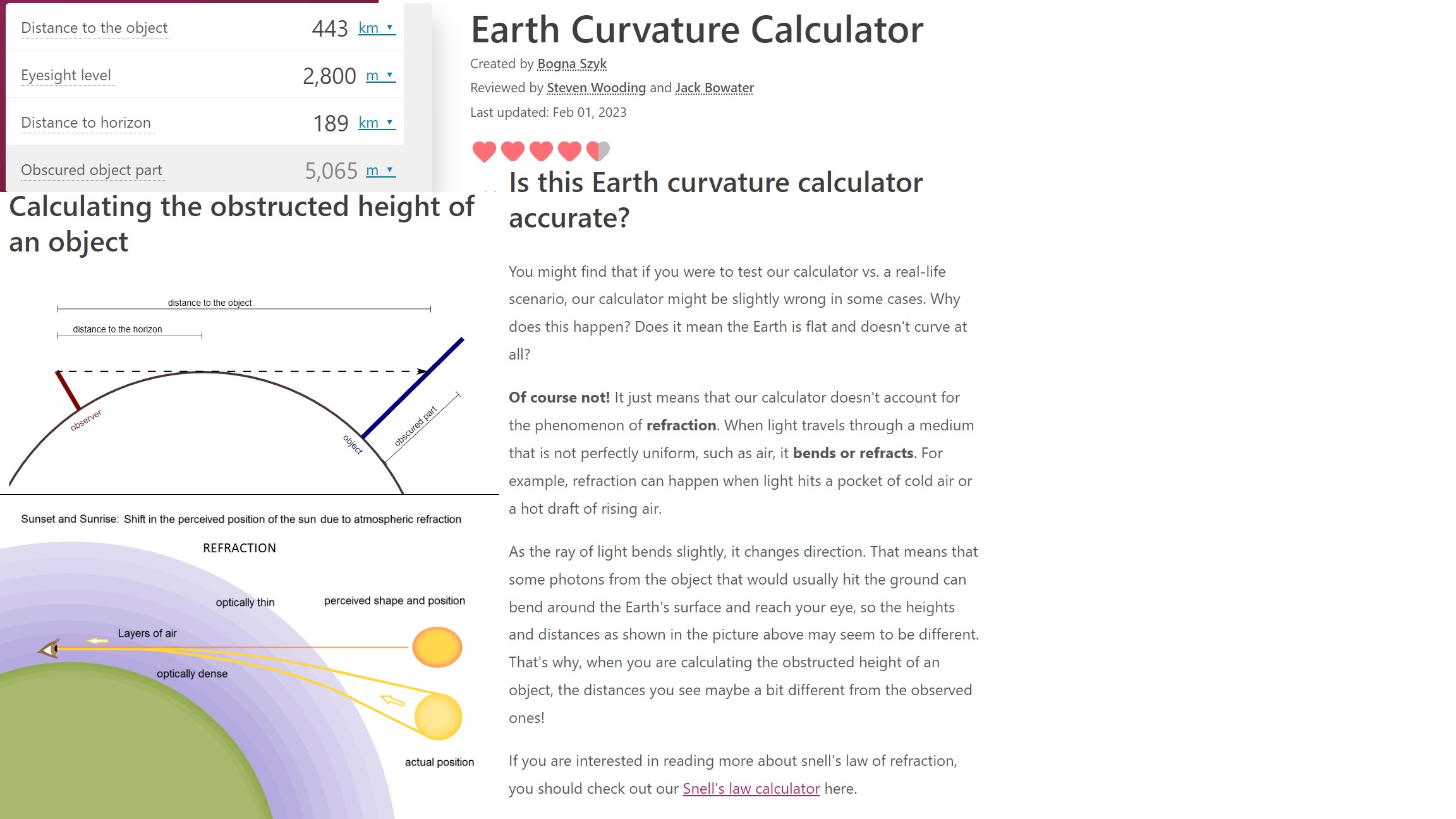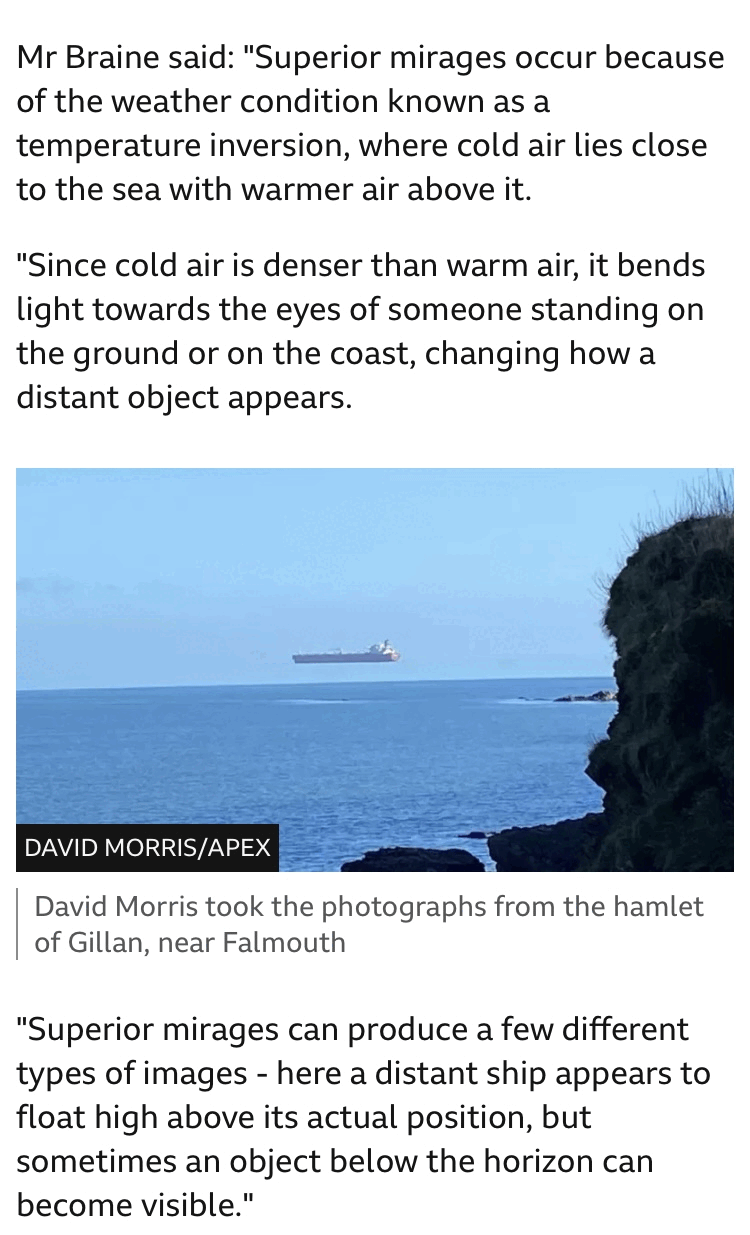It looks like you're using an Ad Blocker.
Please white-list or disable AboveTopSecret.com in your ad-blocking tool.
Thank you.
Some features of ATS will be disabled while you continue to use an ad-blocker.
share:
originally posted by: FlyInTheOintment
a reply to: WhatItIs
Does your sketch approximate what you can see in the photograph? No, no it doesn't.
Lame attempt to debunk using a magic marker & deceptive intent.
One…
You are being intellectually dishonest.
I already posted how over the horizon photography is possible.
originally posted by: WhatItIs
Used this in another thread. But if you are going to make the same thread twice….
Skyline Skepticism: The Lake Michigan Mirage
www.abc57.com...
To those that doubt affects of refraction. The full Chicago skyline should be visible all the time if it weren't the case, barring clouds, rain or fog. However that’s not the case, it is always changing. I encourage anyone to go look for themselves.
So. Refraction is well known.
Back to this post..
originally posted by: cooperton
beyondrange.wordpress.com...
443km is the current record for distance in a photograph. That would be about 15km of curvature if the earth were curved in 3D. No part of that mountain should be visible, even if youre on a 3km high mountain. You can look through that site and see countless examples of defying the curve.
The post totally ignores the height of the vantage point and the target.
One. This closer to the set up of the actual photo.

The world record photo is from a mountain top to a mountain top. Thus the distance to the horizon is greater. If cooperton didn’t compensate for the greater hight of the vantage point and the target, then their assertions are off. And it seems more out of wanting to create a false argument.
Two. The role of refraction is well known. And not to provide such information is blatantly intellectually dishonest.
The Longest Sightlines on Earth
www.amusingplanet.com...
Another factor that can allow for longer sightlines is the temperature of the air. When the air near the earth’s surface is cooler than that above it, a condition known as temperature inversion, the layers of air can bend light in such a manner that it follows the curvature of the earth increasing our line of sight.
I suppose you believe modern steel cargo ships float in mid air too? I have “photographic evidence”…
www.bbc.com...
If you missed it from the screenshot. “but sometimes an object below the horizon can become visible.
edit on 9-2-2023 by WhatItIs because: (no reason given)
edit on 9-2-2023 by WhatItIs because: (no reason
given)
edit on 9-2-2023 by WhatItIs because: (no reason given)
edit on 9-2-2023 by WhatItIs because: (no reason
given)
edit on 9-2-2023 by WhatItIs because: (no reason given)
The only problem i have with the flat earth theory.... with 30yrs experience at at sea...most of my college grad officers were taught celestial
navigation... and two still practice it nightly ...it's based on a sphere inside of a sphere geometry....
originally posted by: DaRAGE
a reply to: cooperton
It's not 15 miles of curvature. It's 5 KM's.
And Refraction of the air allowing you to see those longer distances.
I might have used a faulty calculator, or possibly yours is faulty. But regardless, 5km of obscured object means the 4.1km mountain should be hidden.
The refraction argument can be disproven on frozen lakes where they detect much longer distances than should be allowed by a curve. No refraction will occur because it's all at the same elevation level. Refraction requires a change in air density and it is seldom, if ever, drastic enough to let you see around edges.
Well let's discuss one thing at a time shall we?
originally posted by: cooperton
The refraction argument can be disproven on frozen lakes where they detect much longer distances than should be allowed by a curve. No refraction will occur because it's all at the same elevation level. Refraction requires a change in air density and it is seldom, if ever, drastic enough to let you see around edges.
You brought up the example of mountain peak to mountain peak, and in that case air density definitely changes because density is lower at the mountain peaks, and higher where the line of sight passes close to the ground between the peaks.
There is detailed mathematics actually allowing us to calculate the expected change in elevation due to refraction, and it's typically in the opposite direction of the curvature of the earth. The following page says less than 15% of the curvature of the earth, but you could run some numbers for like 12%, 13%, 14% to look at the effects of a range of the relevant variables.
The Effect Of Atmospheric Refraction On The Observed Elevation Angles Of Peaks
Atmospheric refraction slightly increases the observed elevation angle of a peak relative to the observer. The effect is actually quite complicated, since it depends on the precise atmospheric conditions, including atmospheric pressure, temperature, and water vapor content, and thus varies with time and the altitudes of the observer and the observed peak. Fortunately, the effect of refraction is less than ~15% of the effect due to the curvature of the Earth, and typically only increases the observed elevation angle by less than 0.1°.
Now once you admit that math easily explains your mountain to mountain example at 433 km, then we can move on to discussing frozen lakes if you wish, but let's not confuse and mix up the two cases which it seems you might be doing since you suddenly shifted gears to a frozen lake argument.
edit on 202329 by Arbitrageur because: clarification
originally posted by: sapien82
a reply to: IamOak76
and celestial navigation is how old again
aye pretty damn old right 4000 years old
how would celestial navigation work on a flat earth
or would it at all ?
This might be simpler and more direct…
Equatorial Mounts WOULDN'T WORK on a Flat Earth
m.youtube.com...
edit on 9-2-2023 by WhatItIs because: (no reason given)
edit on 9-2-2023 by WhatItIs because: (no reason given)
I’d like to know the movement of the sun over a flat earth
Can you show a drawing of the flat earth and how the sun traverses over it.
Can you show a drawing of the flat earth and how the sun traverses over it.
edit on 9-2-2023 by DaRAGE because: (no reason given)
a reply to: DaRAGE
You can see a model of the sun moving over the flat earth in this video, starting at 3:40:
Real NASA Astronomer Reviews Flat Earth Simulator
Of course, the NASA astronomer is not favorably impressed with the model.
Sabine Hossenfelder shows a similar model in this video at time 2:03:
theflatearthsociety.org...
You can see a model of the sun moving over the flat earth in this video, starting at 3:40:
Real NASA Astronomer Reviews Flat Earth Simulator
Of course, the NASA astronomer is not favorably impressed with the model.
Sabine Hossenfelder shows a similar model in this video at time 2:03:
That is the explanation on the Flat Earth society web page:
originally posted by: WhatItIs
originally posted by: Arbitrageur
"Not all flat earthers have the same beliefs but in general I think most don't believe in gravity, and think the reason we seem to feel gravity is because the earth is accelerating to simulate gravity."
I’m not sure most believe that.
theflatearthsociety.org...
In the Flat Earth model, 'gravity', rather than being a force, is the upward acceleration of the Earth. The Earth always accelerates upward at 1g, which is equivalent to the gravitational acceleration in the Round Earth model.
edit on 202329 by Arbitrageur because: clarification
Yes because NASA is the only space agency in the world and the US is the only country in the world. There isn't millions of astronomers out there all
over the world and millions of people have not been in airplanes.
Flat Earth is just utterly stupid
Flat Earth is just utterly stupid
a reply to: lordcomac
Proof in the form of long range photography
It's easy to dismiss the lies with your own eyes.
It amazes me how many people refuse to believe their own eyes, preferring the constructs of abstract science instead.
Proof in the form of long range photography
It's easy to dismiss the lies with your own eyes.
It amazes me how many people refuse to believe their own eyes, preferring the constructs of abstract science instead.
a reply to: wildespace
I am rather amused that here in the 21st century, have people this deluded
Thought the "flat earth" argument was settled 400 years ago by Copernicus and Kepler
Gues have some who dont get the message of believe it .........
I am rather amused that here in the 21st century, have people this deluded
Thought the "flat earth" argument was settled 400 years ago by Copernicus and Kepler
Gues have some who dont get the message of believe it .........
originally posted by: Arbitrageur
You brought up the example of mountain peak to mountain peak, and in that case air density definitely changes because density is lower at the mountain peaks, and higher where the line of sight passes close to the ground between the peaks.
There is detailed mathematics actually allowing us to calculate the expected change in elevation due to refraction, and it's typically in the opposite direction of the curvature of the earth. The following page says less than 15% of the curvature of the earth, but you could run some numbers for like 12%, 13%, 14% to look at the effects of a range of the relevant variables.
The Effect Of Atmospheric Refraction On The Observed Elevation Angles Of Peaks
Atmospheric refraction slightly increases the observed elevation angle of a peak relative to the observer. The effect is actually quite complicated, since it depends on the precise atmospheric conditions, including atmospheric pressure, temperature, and water vapor content, and thus varies with time and the altitudes of the observer and the observed peak. Fortunately, the effect of refraction is less than ~15% of the effect due to the curvature of the Earth, and typically only increases the observed elevation angle by less than 0.1°.
The bolded portion is what we're looking for here. 0.1°angle difference is the max of what is expected. This means that it could not account for the vast distances observed, and therefore does not resolve the long distance photography that is consistently exhibited. Here is a calculator that shows that air pressure is barely effective on the refractive index:
emtoolbox.nist.gov...
Go ahead and plug in drastic differences in air pressure, and you will see it minimally effects the refractive index. Meaning that even if there were vast differences in air pressure / density it would not allow you to see around the curve as drastically as you would hope. Quite frankly this further affirms that long distance photography proves a flat topography of earth.
As a reminder, there are explanations that resolve the flat phenomenon with the apparent spherical phenomenon of this earthly plane.
originally posted by: FlyInTheOintment
a reply to: cooperton
Keep fighting the good fight, thanks for your efforts.
Being willing to follow the evidence no matter how taboo it may be is the source of all theories that further the understanding of our physical world. I get enthusiastic about new theories based on real evidence, and I think others should as well. As I grow older I realize much of what we have been told is incomplete at best and some times flat out wrong. It's fun to ask the good questions with you all
edit on 9-2-2023 by cooperton because: (no reason given)
originally posted by: cooperton
Being willing to follow the evidence
Let’s just ignore how you gloss over important facts.
Bet you can’t draw how the sun sets on a flat earth to be physically blocked from view, and how the light of the sun is blocked by the earth’s horizon to create earth’s shadow we call night fall.
originally posted by: cooperton
originally posted by: Arbitrageur
Then some flat earthers come up with some really bizarre arguments, like one guy who tried to argue that the reason the tops of multiple poles placed a distance apart didn't all line up wasn't because the earth was curved (which was the right answer), but because the mass of the earth was bending the light! The problem with this of course is that flat earthers all apparently know approximately zero math and he had never tried doing any calculations to see how much the light would actually bend according to general relativity. The sun is far more massive than the earth and even the sun bends the light so slightly that the bend was difficult to measure when it was first measured in 1919.
But this is assuming the contemporary theory is true. If earth has a flat spacetime topology, which is a viable mathematical possibility in Einstein's field equations, then it would totally change the distances of these objects. This would make the observations made by Eddington show that gravitational lensing is even more potent than we thought before.
I wouldn't be pursuing an explanation for flat spacetime topology if photographers weren't constantly defying a curved topology of the earth:
beyondrange.wordpress.com...
443km is the current record for distance in a photograph. That would be about 15km of curvature if the earth were curved in 3D. No part of that mountain should be visible, even if youre on a 3km high mountain. You can look through that site and see countless examples of defying the curve.
From where I live there is a clear sight line to Mt. Baker in Washington. I've seen it numerous times in life, never distorted like a mirage and it shouldn't be visible at all. Checked on a curvature calculator and the top should have be just below the horizon. Don't think a lensing effect or mirage could show the whole thing clearly or that often. I see it driving along the ocean so virtually at sea level.
originally posted by: WhatItIs
Let’s just ignore how you gloss over important facts.
You just ignored an abundance of photographic evidence that there's no curve. You also just ignored that refraction is not possibly responsible for such apparent flatness
Bet you can’t draw how the sun sets on a flat earth to be physically blocked from view, and how the light of the sun is blocked by the earth’s horizon to create earth’s shadow we call night fall.
originally posted by: DaRAGE
I’d like to know the movement of the sun over a flat earth
Can you show a drawing of the flat earth and how the sun traverses over it.
Gravitational lensing is a fundamental aspect of Einstein's relativity theory, the prevailing theory of astronomical bodies.
If the gravitational lensing of the light from the Sun is equal to pi/2, given a distance of one earth radius, voila... an explanation for why half of the earth receives sunlight while the other half does not. Such drastic gravitational lensing is theoretically possible:
www.sciencedirect.com...
"The angles (of gravitational lensing) vary from 0 to 2pi..."
Our astronomical system is a 4-dimensional structure and cannot be properly defined with 3-dimensional Newtonian physics.
edit on 9-2-2023 by
cooperton because: (no reason given)
a reply to: FlyInTheOintment
Did you not see my post above? First one at the top of page 6.
It's called Refraction. Allowing you to see objects beyond the horizon, beyond the curve of the earth.
Also why the mountains look like they are on a flat plane and there is no curvature from one side of the mountains to the other side.
It's because they aren't long enough distances away from each other. The route to drive between the mountains is 56 kilometers. , and if that was straight between mountains it would only incur a 200- meter drop. Not much compared to those 4.1km high mountains. I'm betting less than a 100 meter drop in curvature... grande tete de l'Obiou to tete de vacheres.

Did you not see my post above? First one at the top of page 6.
It's called Refraction. Allowing you to see objects beyond the horizon, beyond the curve of the earth.
Also why the mountains look like they are on a flat plane and there is no curvature from one side of the mountains to the other side.
It's because they aren't long enough distances away from each other. The route to drive between the mountains is 56 kilometers. , and if that was straight between mountains it would only incur a 200- meter drop. Not much compared to those 4.1km high mountains. I'm betting less than a 100 meter drop in curvature... grande tete de l'Obiou to tete de vacheres.

edit on 9-2-2023 by DaRAGE because: (no reason given)
edit on 9-2-2023 by DaRAGE because: (no reason
given)
new topics
top topics
-
Federal law trumps state and local law every time
Social Issues and Civil Unrest: 17 hours ago, 17 flags
active topics
-
Petition Calling for General Election at 564,016 and rising Fast
Political Issues • 94 • : Freeborn -
-@TH3WH17ERABB17- -Q- ---TIME TO SHOW THE WORLD--- -Part- --44--
Dissecting Disinformation • 3384 • : brewtiger123 -
BIDEN Admin Begins Planning For January 2025 Transition to a New President - Today is 4.26.2024.
2024 Elections • 59 • : WeMustCare -
DOJ Special Counsel Robert HUR Says JOE BIDEN Can Be ARRESTED After Jan 20th 2025.
Above Politics • 30 • : WeMustCare -
On Nov. 5th 2024 - AMERICANS Prevented the Complete Destruction of America from Within.
2024 Elections • 160 • : WeMustCare -
Results of the use of the Oreshnik missile system in Dnepropetrovsk
World War Three • 240 • : 777Vader -
Both KAMALA and OBAMA are on the Nov 5th 2024 Ballot - If One Loses - Both Lose.
2024 Elections • 9 • : WeMustCare -
How many people, in GENERAL, are musically inclined?
Music • 26 • : Huronyx -
Well, here we go red lines crossed Biden gives the go ahead to use long range missiles
World War Three • 395 • : annonentity -
Federal law trumps state and local law every time
Social Issues and Civil Unrest • 30 • : ADVISOR



